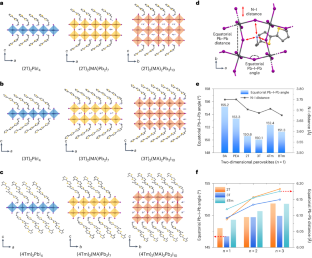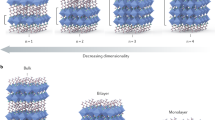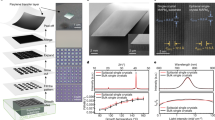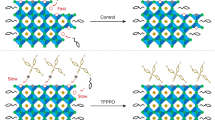Abstract
Two-dimensional organic semiconductor-incorporated perovskites are a promising family of hybrid materials for optoelectronic applications, owing in part to their inherent quantum well architecture. Tuning their structures and properties for specific properties, however, has remained challenging. Here we report a general method to tune the dimensionality of phase-pure organic semiconductor-incorporated perovskite single crystals during their synthesis, by judicious choice of solvent. The length of the conjugated semiconducting organic cations and the dimensionality (n value) of the inorganic layers can be manipulated at the same time. The energy band offsets and exciton dynamics at the organic–inorganic interfaces can therefore be precisely controlled. Furthermore, we show that longer and more planar π-conjugated organic cations induce a more rigid inorganic crystal lattice, which leads to suppressed exciton–phonon interactions and better optoelectronic properties as compared to conventional two-dimensional perovskites. As a demonstration, optically driven lasing behaviour with substantially lower lasing thresholds was realized.

This is a preview of subscription content, access via your institution
Access options
Access Nature and 54 other Nature Portfolio journals
Get Nature+, our best-value online-access subscription
$29.99 / 30 days
cancel any time
Subscribe to this journal
Receive 12 print issues and online access
$259.00 per year
only $21.58 per issue
Buy this article
- Purchase on Springer Link
- Instant access to full article PDF
Prices may be subject to local taxes which are calculated during checkout





Similar content being viewed by others
Data availability
Crystallographic data for the structures reported in this Article have been deposited at the Cambridge Crystallographic Data Centre under deposition numbers CCDC 2151387 ((2T)2(MA)Pb2I7), CCDC 2151388 ((2T)2(MA)2Pb3I10), CCDC 2151389 ((3T)2PbI4), CCDC 2151390 ((3T)2(MA)Pb2I7), CCDC 2151391 ((4Tm)2(MA)Pb2I7) and CCDC 2191050 ((3T)2(MA)2Pb3I10). Crystallographic data can be obtained free of charge through https://www.ccdc.cam.ac.uk/structures/. All the input and output files relevant to the theoretical simulations in this work have been deposited to NOMAD; access the following for more information: https://doi.org/10.17172/NOMAD/2023.03.18-1. All other data are available in the manuscript or Supplementary Information. All materials are available upon request to L.D. Source data are provided with this paper.
References
Ishihara, T., Takahashi, J. & Goto, T. Exciton state in two-dimensional perovskite semiconductor (C10H21NH3)2PbI4. Solid State Commun. 69, 933–936 (1989).
Katan, C., Mercier, N. & Even, J. Quantum and dielectric confinement effects in lower-dimensional hybrid perovskite semiconductors. Chem. Rev. 119, 3140–3192 (2019).
Tsai, H. et al. High-efficiency two-dimensional Ruddlesden–Popper perovskite solar cells. Nature 536, 312–317 (2016).
Wang, N. et al. Perovskite light-emitting diodes based on solution-processed self-organized multiple quantum wells. Nat. Photon. 10, 699–704 (2016).
Zhang, Q., Chu, L., Zhou, F., Ji, W. & Eda, G. Excitonic properties of chemically synthesized 2D organic–inorganic hybrid perovskite nanosheets. Adv. Mater. 30, 1704055 (2018).
Blancon, J., Even, J., Stoumpos, C. C., Kanatzidis, M. G. & Mohite, A. D. Semiconductor physics of organic–inorganic 2D halide perovskites. Nat. Nanotechnol. 15, 969–985 (2020).
Dou, L. et al. Atomically thin two-dimensional organic-inorganic hybrid perovskites. Science 349, 1518–1521 (2015).
Mitzi, D. B. Templating and structural engineering in organic–inorganic perovskites. J. Chem. Soc. Dalt. Trans. https://doi.org/10.1039/b007070j (2001).
Saparov, B. & Mitzi, D. B. Organic–inorganic perovskites: structural versatility for functional materials design. Chem. Rev. 116, 4558–4596 (2016).
Leng, K., Fu, W., Liu, Y., Chhowalla, M. & Loh, K. P. From bulk to molecularly thin hybrid perovskites. Nat. Rev. Mater. 5, 482–500 (2020).
Shi, E. et al. Two-dimensional halide perovskite nanomaterials and heterostructures. Chem. Soc. Rev. 47, 6046–6072 (2018).
Ricciardulli, A. G., Yang, S., Smet, J. H. & Saliba, M. Emerging perovskite monolayers. Nat. Mater. 20, 1325–1336 (2021).
Hu, J., Yan, L. & You, W. Two-dimensional organic-inorganic hybrid perovskites: a new platform for optoelectronic applications. Adv. Mater. 30, 1802041 (2018).
Raghavan, C. M. et al. Low-threshold lasing from 2D homologous organic–inorganic hybrid Ruddlesden–Popper perovskite single crystals. Nano Lett. 18, 3221–3228 (2018).
Zhang, H. et al. 2D Ruddlesden–Popper perovskites microring laser array. Adv. Mater. 30, 1706186 (2018).
Zhang, F. et al. Enhanced charge transport in 2D perovskites via fluorination of organic cation. J. Am. Chem. Soc. 141, 5972–5979 (2019).
Xiao, X. et al. Ultrafast exciton transport with a long diffusion length in layered perovskites with organic cation functionalization. Adv. Mater. 32, 2004080 (2020).
Gao, Y. & Dou, L. Organic semiconductor-incorporated two-dimensional halide perovskites. Natl Sci. Rev. 9, nwab111 (2021).
Chondroudis, K. & Mitzi, D. B. Electroluminescence from an organic–inorganic perovskite incorporating a quaterthiophene dye within lead halide perovskite layers. Chem. Mater. 11, 3028–3030 (1999).
Mitzi, D. B., Chondroudis, K. & Kagan, C. R. Design, structure, and optical properties of organic–inorganic perovskites containing an oligothiophene chromophore. Inorg. Chem. 38, 6246–6256 (1999).
Takeoka, Y., Asai, K., Rikukawa, M. & Sanui, K. Incorporation of conjugated polydiacetylene systems into organic–inorganic quantum-well structures. Chem. Commun. 1, 2592–2593 (2001).
Mao, L. et al. Seven-layered 2D hybrid lead iodide perovskites. Chem 5, 2593–2604 (2019).
Stoumpos, C. C. et al. Ruddlesden–Popper hybrid lead iodide perovskite 2D homologous semiconductors. Chem. Mater. 28, 2852–2867 (2016).
Oswald, I. W. H., Koegel, A. A. & Neilson, J. R. General synthesis principles for Ruddlesden–Popper hybrid perovskite halides from a dynamic equilibrium. Chem. Mater. 30, 8606–8614 (2018).
Snyder, L. R. Classification off the solvent properties of common liquids. J. Chromatogr. Sci. 16, 223–234 (1978).
Mao, L. et al. Hybrid Dion–Jacobson 2D lead iodide perovskites. J. Am. Chem. Soc. 140, 3775–3783 (2018).
Mitzi, D. B. Synthesis, crystal structure, and optical and thermal properties of (C4H9NH3)2MI4 (M = Ge, Sn, Pb). Chem. Mater. 8, 791–800 (1996).
Du, K. Z. et al. Two-dimensional lead(II) halide-based hybrid perovskites templated by acene alkylamines: crystal structures, optical properties, and piezoelectricity. Inorg. Chem. 56, 9291–9302 (2017).
Dunlap-Shohl, W. A. et al. Tunable internal quantum well alignment in rationally designed oligomer-based perovskite films deposited by resonant infrared matrix-assisted pulsed laser evaporation. Mater. Horizons 6, 1707–1716 (2019).
Silver, S., Dai, Q., Li, H., Brédas, J. L. & Kahn, A. Quantum well energetics of an n = 2 Ruddlesden–Popper phase perovskite. Adv. Energy Mater. 9, 1901005 (2019).
Ammirati, G. et al. Band structure and exciton dynamics in Quasi-2D dodecylammonium halide perovskites. Adv. Opt. Mater. 11, 2201874 (2023).
Steger, M. et al. On the optical anisotropy in 2D metal-halide perovskites. Nanoscale 14, 752–765 (2022).
Janke, S. M., Qarai, M. B., Blum, V. & Spano, F. C. Frenkel–Holstein Hamiltonian applied to absorption spectra of quaterthiophene-based 2D hybrid organic-inorganic perovskites. J. Chem. Phys. 152, 144702 (2020).
Gao, Y. et al. Molecular engineering of organic–inorganic hybrid perovskites quantum wells. Nat. Chem. 11, 1151–1157 (2019).
Liu, C. et al. Tunable semiconductors: control over carrier states and excitations in layered hybrid organic–inorganic perovskites. Phys. Rev. Lett. 121, 146401 (2018).
Jana, M. K. et al. Resolving rotational stacking disorder and electronic level alignment in a 2D oligothiophene-based lead iodide perovskite. Chem. Mater. 31, 8523–8532 (2019).
Deng, S. et al. Long-lived charge separation in two-dimensional ligand-perovskite heterostructures. J. Chem. Phys. 152, 044711 (2020).
Wang, S. et al. Temperature-dependent band gap in two-dimensional perovskites: thermal expansion interaction and electron–phonon interaction. J. Phys. Chem. Lett. 10, 2546–2553 (2019).
Yu, C. et al. Temperature dependence of the band gap of perovskite semiconductor compound CsSnI3. J. Appl. Phys. 110, 063526 (2011).
Gong, X. et al. Electron–phonon interaction in efficient perovskite blue emitters. Nat. Mater. 17, 550–556 (2018).
Trueblood, K. N. et al. Atomic displacement parameter nomenclature report of a subcommittee on atomic displacement parameter nomenclature. Acta Crystallogr. A Found. Crystallogr. 52, 770–781 (1996).
Dhanabalan, B. et al. Directional anisotropy of the vibrational modes in 2D-layered perovskites. ACS Nano 14, 4689–4697 (2020).
Quan, L. N. et al. Vibrational relaxation dynamics in layered perovskite quantum wells. Proc. Natl Acad. Sci. USA 118, e2104425118 (2021).
Menahem, M. et al. Strongly anharmonic octahedral tilting in two-dimensional hybrid halide perovskites. ACS Nano 15, 10153–10162 (2021).
Barman, S., Venkataraman, N. V., Vasudevan, S. & Seshadri, R. Phase transitions in the anchored organic bilayers of long-chain alkylammonium lead iodides (CnH2n+1NH3)2PbI4; n = 12, 16, 18. J. Phys. Chem. B 107, 1875–1883 (2003).
Tu, Q. et al. Out-of-plane mechanical properties of 2D hybrid organic–inorganic perovskites by nanoindentation. ACS Appl. Mater. Interfaces 10, 22167–22173 (2018).
Du, Q. et al. Stacking effects on electron–phonon coupling in layered hybrid perovskites via microstrain manipulation. ACS Nano 14, 5806–5817 (2020).
Lee, J., Koteles, E. S. & Vassell, M. O. Luminescence linewidths of excitons in GaAs quantum wells below 150 K. Phys. Rev. A 33, 5512–5516 (1986).
Handa, T., Aharen, T., Wakamiya, A. & Kanemitsu, Y. Radiative recombination and electron-phonon coupling in lead-free CH3NH3SnI3 perovskite thin films. Phys. Rev. Mater. 2, 075402 (2018).
Ni, L. et al. Real-time observation of exciton–phonon coupling dynamics in self-assembled hybrid perovskite quantum wells. ACS Nano 11, 10834–10843 (2017).
Chen, Z. et al. Remote phononic effects in epitaxial Ruddlesden–Popper halide perovskites. J. Phys. Chem. Lett. 9, 6676–6682 (2018).
Straus, D. B. et al. Direct observation of electron–phonon coupling and slow vibrational relaxation in organic–inorganic hybrid perovskites. J. Am. Chem. Soc. 138, 13798–13801 (2016).
Guo, P. et al. Cross-plane coherent acoustic phonons in two-dimensional organic–inorganic hybrid perovskites. Nat. Commun. 9, 2019 (2018).
Maity, P. et al. Layer-dependent coherent acoustic phonons in two-dimensional Ruddlesden–Popper perovskite crystals. J. Phys. Chem. Lett. 10, 5259–5264 (2019).
Long, H. et al. Exciton–phonon interaction in quasi-two dimensional layered (PEA)2(CsPbBr3)n–1PbBr4 perovskite. Nanoscale 11, 21867–21871 (2019).
Liang, Y. et al. Lasing from mechanically exfoliated 2D homologous Ruddlesden–Popper perovskite engineered by inorganic layer thickness. Adv. Mater. 31, 1903030 (2019).
Guthrie, D. A. & Tovar, J. D. Conformation as a protecting group: a regioselective aromatic bromination en route to complex π-electron systems. Org. Lett. 10, 4323–4326 (2008).
Balandier, J. Y. et al. Synthesis of soluble oligothiophenes bearing cyano groups, their optical and electrochemical properties. Tetrahedron 66, 9560–9572 (2010).
Harvey, C. P. & Tovar, J. D. Pi-conjugated chain extenders for the synthesis of optoelectronic segmented polyurethanes. J. Polym. Sci. A Polym. Chem. 49, 4861–4874 (2011).
Wang, X. X. et al.Dipyrido[3,2-a:2′,3′-c]phenazine-based donor–acceptor aromatic heterocyclic compounds with thienyl and triphenylamino chromophores at the 2,7- and/or 10,13-positions. Chem. Asian J. 9, 514–525 (2014).
Keller, N. et al. Oligothiophene-bridged conjugated covalent organic frameworks. J. Am. Chem. Soc. 139, 8194–8199 (2017).
Deng, S. et al. Long-range exciton transport and slow annihilation in two-dimensional hybrid perovskites. Nat. Commun. 11, 664 (2020).
Wang, K. et al. Lead-free organic-perovskite hybrid quantum wells for highly stable light-emitting diodes. ACS Nano 15, 6316–6325 (2021).
Blum, V. et al. Ab initio molecular simulations with numeric atom-centered orbitals. Comput. Phys. Commun. 180, 2175–2196 (2009).
Perdew, J. P., Burke, K. & Ernzerhof, M. Generalized gradient approximation made simple. Phys. Rev. Lett. 77, 3865–3868 (1996).
Tkatchenko, A. & Scheffler, M. Accurate molecular van der Waals interactions from ground-state electron density and free-atom reference data. Phys. Rev. Lett. 102, 6–9 (2009).
Heyd, J., Scuseria, G. E. & Ernzerhof, M. Hybrid functionals based on a screened Coulomb potential. J. Chem. Phys. 118, 8207–8215 (2003).
Heyd, J., Scuseria, G. E. & Ernzerhof, M. Erratum: “Hybrid functionals based on a screened Coulomb potential” [Journal of Chemical Physics (2003) 118 (8207)]. J. Chem. Phys. 124, 219906 (2006).
Krukau, A. V., Vydrov, O. A., Izmaylov, A. F. & Scuseria, G. E. Influence of the exchange screening parameter on the performance of screened hybrid functionals. J. Chem. Phys. 125, 224106 (2006).
Huhn, W. P. & Blum, V. One-hundred-three compound band-structure benchmark of post-self-consistent spin–orbit coupling treatments in density functional theory. Phys. Rev. Mater. 1, 033803 (2017).
Kim, S. et al. A band-gap database for semiconducting inorganic materials calculated with hybrid functional. Sci. Data 7, 387 (2020).
Acknowledgements
We thank D. Mitzi and M. K. Jana for help with single-crystal X-ray diffraction studies. We also thank K. Zhao and X. Wang at the School of Mechanical Engineering, Purdue University for the nanoindentation experiments. The work of J.Y.P. and L.D. is supported by the National Science Foundation under award no. 2110706-DMR (crystal synthesis). The work of L.J. and L.H. is supported by the US Department of Energy, Office of Basic Energy Sciences under award no. DE-SC0022082 (spectroscopy characterization). The work of R.S. and V.B. is supported by the National Science Foundation under award no. DMR-1729297 (DFT calculations). The work of J.L. and Y.S.Z. is supported by the New Cornerstone Science Foundation through the Xplorer Prize. This research used resources of the National Energy Research Scientific Computing Center (NERSC), a US Department of Energy Office of Science User Facility operated under contract no. DE-AC02-05CH11231. The single-crystal X-ray diffractometer was purchased with support from the National Science Foundation under award no. CHE 1625543. This research used resources of the Advanced Light Source, which is a US Department of Energy Office of Science User Facility, under contract no. DE-AC02-05CH11231.
Author information
Authors and Affiliations
Contributions
J.Y.P. carried out the synthesis, characterization of the materials and overall data analysis. R.S. and V.B. performed the DFT simulations. J.L. and Y.S.Z. characterized the temperature-dependent lasing properties of the materials. L.J. and L.H. carried out the temperature-dependent ultrafast spectroscopy measurements. K.W. provided insight regarding characterization and overall data analysis. E.S. and Y.G. contributed to the synthesis of materials. M.Z. and S.J.T. performed the single-crystal structure determinations. S.L. and P.G. carried out the low-frequency Raman scattering measurements. J.Y.P. and L.D. wrote the manuscript; all authors read and revised the manuscript. L.D. supervised the project.
Corresponding authors
Ethics declarations
Competing interests
V.B. is a member of the executive board of MS1P e.V., the non-profit organization that licences the FHI-aims electronic structure code used in this work. V.B. does not receive any financial gains from this position. L.D. and Y.G. are inventors of a patent application (US10618889B2, active) related to the molecular design of the organic cations and the synthesis of the hybrid crystals presented in this work. All other authors declare no competing interests.
Peer review
Peer review information
Nature Chemistry thanks Qing Zhang and the other, anonymous, reviewer(s) for their contribution to the peer review of this work.
Additional information
Publisher’s note Springer Nature remains neutral with regard to jurisdictional claims in published maps and institutional affiliations.
Supplementary information
Supplementary Information
Supplementary Figs. 1–36, Tables 1–10, references and appendix.
Supplementary Data 1
Crystal structure for 2T n = 2.
Supplementary Data 2
Crystal structure for 2T n = 3.
Supplementary Data 3
Crystal structure for 3T n = 1.
Supplementary Data 4
Crystal structure for 3T n = 2.
Supplementary Data 5
Crystal structure for 3T n = 3.
Supplementary Data 6
Crystal structure for 4Tm n = 2.
Supplementary Data 7
Graph source data for Supplementary Fig. 11.
Supplementary Data 8
Graph source data for Supplementary Fig. 12.
Supplementary Data 9
Graph source data for Supplementary Fig. 29.
Supplementary Data 10
Graph source data for Supplementary Fig. 30.
Supplementary Data 11
Graph source data for Supplementary Fig. 31.
Supplementary Data 12
Graph source data for Supplementary Fig. 32.
Supplementary Data 13
Graph source data for Supplementary Fig. 33.
Supplementary Data 14
Graph source data for Supplementary Fig. 34.
Supplementary Data 15
Graph source data for Supplementary Fig. 35.
Source data
Source Data Fig. 1
Graph source data.
Source Data Fig. 4
Graph source data.
Source Data Fig. 5
Graph source data.
Rights and permissions
Springer Nature or its licensor (e.g. a society or other partner) holds exclusive rights to this article under a publishing agreement with the author(s) or other rightsholder(s); author self-archiving of the accepted manuscript version of this article is solely governed by the terms of such publishing agreement and applicable law.
About this article
Cite this article
Park, J.Y., Song, R., Liang, J. et al. Thickness control of organic semiconductor-incorporated perovskites. Nat. Chem. 15, 1745–1753 (2023). https://doi.org/10.1038/s41557-023-01311-0
Received:
Accepted:
Published:
Issue Date:
DOI: https://doi.org/10.1038/s41557-023-01311-0



